Impact of Sugary Drinks Ban on Health: A Media & Social Analysis
VerifiedAdded on 2022/09/02
|12
|2394
|9
Homework Assignment
AI Summary
This assignment analyzes the societal trend towards healthier food and drink options, focusing on the issue of sugary drinks and the push to ban them in healthcare facilities. The student identifies the Australian Beverage Council as a relevant organization and examines media releases and articles from various sources, including ABC News, The New York Times, and The Guardian, to understand the language used, the tone, and the arguments presented. The assignment also includes a media content analysis of selected articles. Furthermore, the assignment delves into social media discussions, identifying keywords and phrases for searches on platforms like Facebook, and analyzes the sentiment expressed in posts and comments, incorporating a word cloud generated from the comments. The student references multiple sources to support their analysis and draws conclusions about the overall sentiment and the impact of the issue on public discourse.
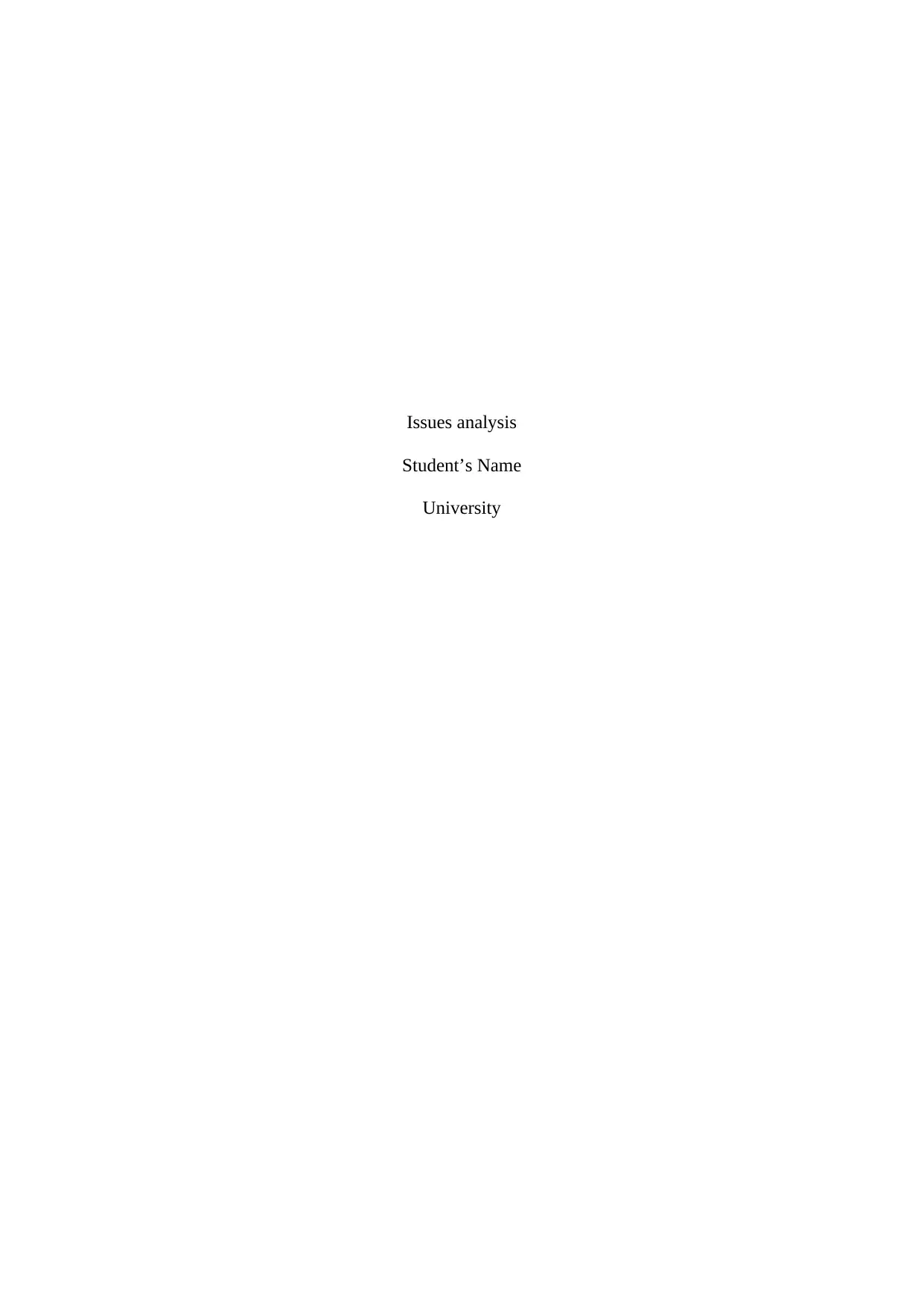
Issues analysis
Student’s Name
University
Student’s Name
University
Paraphrase This Document
Need a fresh take? Get an instant paraphrase of this document with our AI Paraphraser
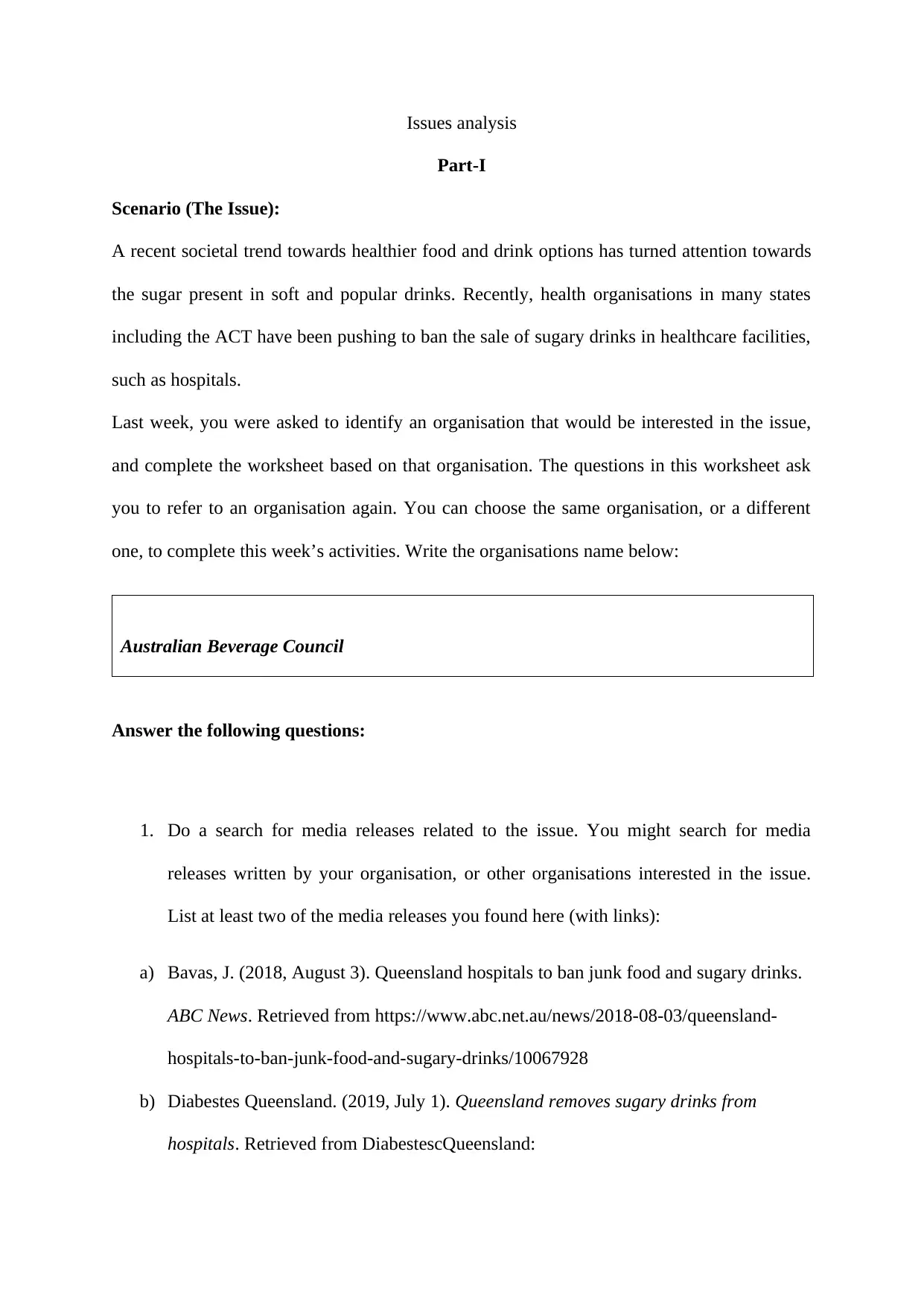
Issues analysis
Part-I
Scenario (The Issue):
A recent societal trend towards healthier food and drink options has turned attention towards
the sugar present in soft and popular drinks. Recently, health organisations in many states
including the ACT have been pushing to ban the sale of sugary drinks in healthcare facilities,
such as hospitals.
Last week, you were asked to identify an organisation that would be interested in the issue,
and complete the worksheet based on that organisation. The questions in this worksheet ask
you to refer to an organisation again. You can choose the same organisation, or a different
one, to complete this week’s activities. Write the organisations name below:
Australian Beverage Council
Answer the following questions:
1. Do a search for media releases related to the issue. You might search for media
releases written by your organisation, or other organisations interested in the issue.
List at least two of the media releases you found here (with links):
a) Bavas, J. (2018, August 3). Queensland hospitals to ban junk food and sugary drinks.
ABC News. Retrieved from https://www.abc.net.au/news/2018-08-03/queensland-
hospitals-to-ban-junk-food-and-sugary-drinks/10067928
b) Diabestes Queensland. (2019, July 1). Queensland removes sugary drinks from
hospitals. Retrieved from DiabestescQueensland:
Part-I
Scenario (The Issue):
A recent societal trend towards healthier food and drink options has turned attention towards
the sugar present in soft and popular drinks. Recently, health organisations in many states
including the ACT have been pushing to ban the sale of sugary drinks in healthcare facilities,
such as hospitals.
Last week, you were asked to identify an organisation that would be interested in the issue,
and complete the worksheet based on that organisation. The questions in this worksheet ask
you to refer to an organisation again. You can choose the same organisation, or a different
one, to complete this week’s activities. Write the organisations name below:
Australian Beverage Council
Answer the following questions:
1. Do a search for media releases related to the issue. You might search for media
releases written by your organisation, or other organisations interested in the issue.
List at least two of the media releases you found here (with links):
a) Bavas, J. (2018, August 3). Queensland hospitals to ban junk food and sugary drinks.
ABC News. Retrieved from https://www.abc.net.au/news/2018-08-03/queensland-
hospitals-to-ban-junk-food-and-sugary-drinks/10067928
b) Diabestes Queensland. (2019, July 1). Queensland removes sugary drinks from
hospitals. Retrieved from DiabestescQueensland:
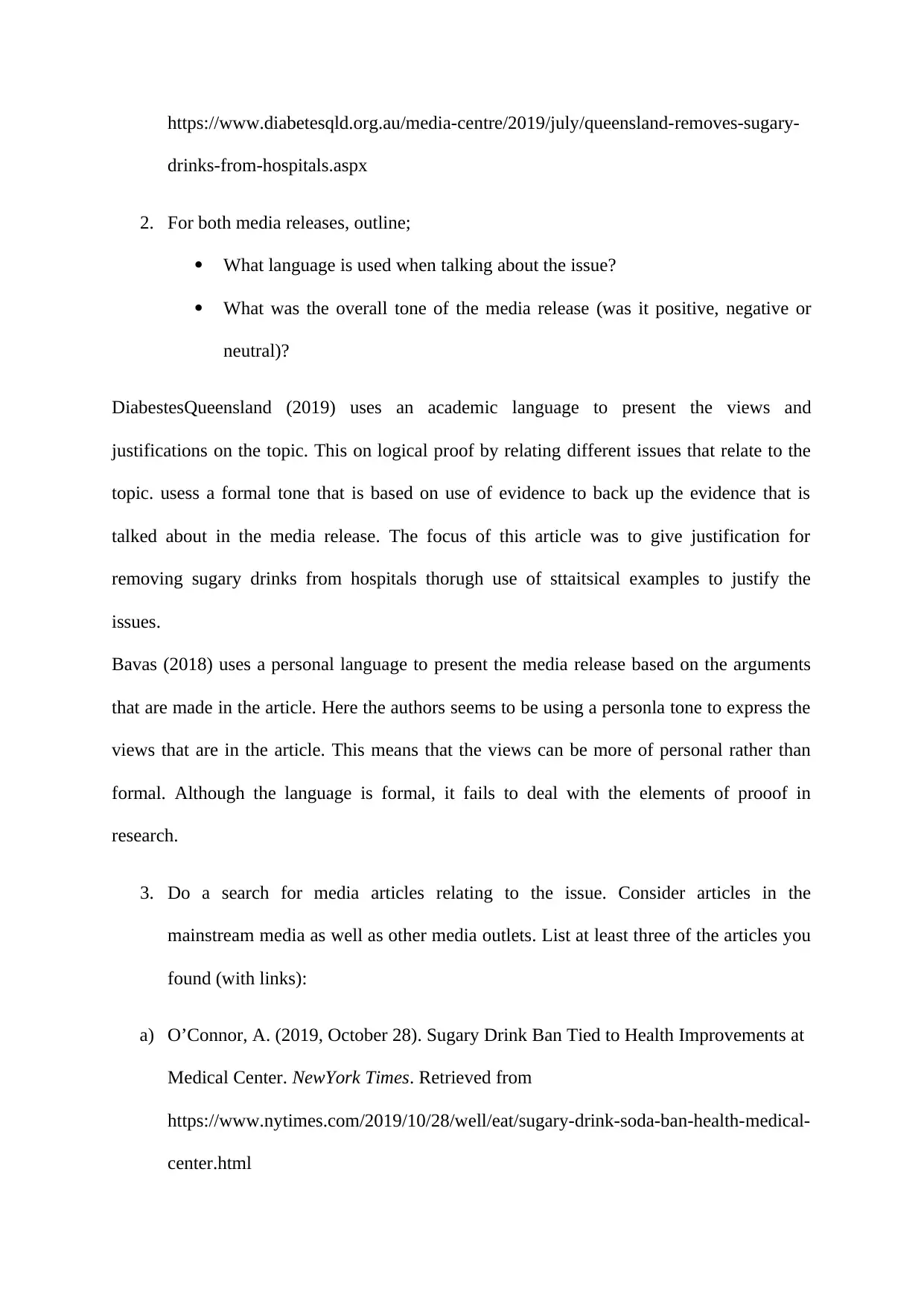
https://www.diabetesqld.org.au/media-centre/2019/july/queensland-removes-sugary-
drinks-from-hospitals.aspx
2. For both media releases, outline;
What language is used when talking about the issue?
What was the overall tone of the media release (was it positive, negative or
neutral)?
DiabestesQueensland (2019) uses an academic language to present the views and
justifications on the topic. This on logical proof by relating different issues that relate to the
topic. usess a formal tone that is based on use of evidence to back up the evidence that is
talked about in the media release. The focus of this article was to give justification for
removing sugary drinks from hospitals thorugh use of sttaitsical examples to justify the
issues.
Bavas (2018) uses a personal language to present the media release based on the arguments
that are made in the article. Here the authors seems to be using a personla tone to express the
views that are in the article. This means that the views can be more of personal rather than
formal. Although the language is formal, it fails to deal with the elements of prooof in
research.
3. Do a search for media articles relating to the issue. Consider articles in the
mainstream media as well as other media outlets. List at least three of the articles you
found (with links):
a) O’Connor, A. (2019, October 28). Sugary Drink Ban Tied to Health Improvements at
Medical Center. NewYork Times. Retrieved from
https://www.nytimes.com/2019/10/28/well/eat/sugary-drink-soda-ban-health-medical-
center.html
drinks-from-hospitals.aspx
2. For both media releases, outline;
What language is used when talking about the issue?
What was the overall tone of the media release (was it positive, negative or
neutral)?
DiabestesQueensland (2019) uses an academic language to present the views and
justifications on the topic. This on logical proof by relating different issues that relate to the
topic. usess a formal tone that is based on use of evidence to back up the evidence that is
talked about in the media release. The focus of this article was to give justification for
removing sugary drinks from hospitals thorugh use of sttaitsical examples to justify the
issues.
Bavas (2018) uses a personal language to present the media release based on the arguments
that are made in the article. Here the authors seems to be using a personla tone to express the
views that are in the article. This means that the views can be more of personal rather than
formal. Although the language is formal, it fails to deal with the elements of prooof in
research.
3. Do a search for media articles relating to the issue. Consider articles in the
mainstream media as well as other media outlets. List at least three of the articles you
found (with links):
a) O’Connor, A. (2019, October 28). Sugary Drink Ban Tied to Health Improvements at
Medical Center. NewYork Times. Retrieved from
https://www.nytimes.com/2019/10/28/well/eat/sugary-drink-soda-ban-health-medical-
center.html
⊘ This is a preview!⊘
Do you want full access?
Subscribe today to unlock all pages.

Trusted by 1+ million students worldwide
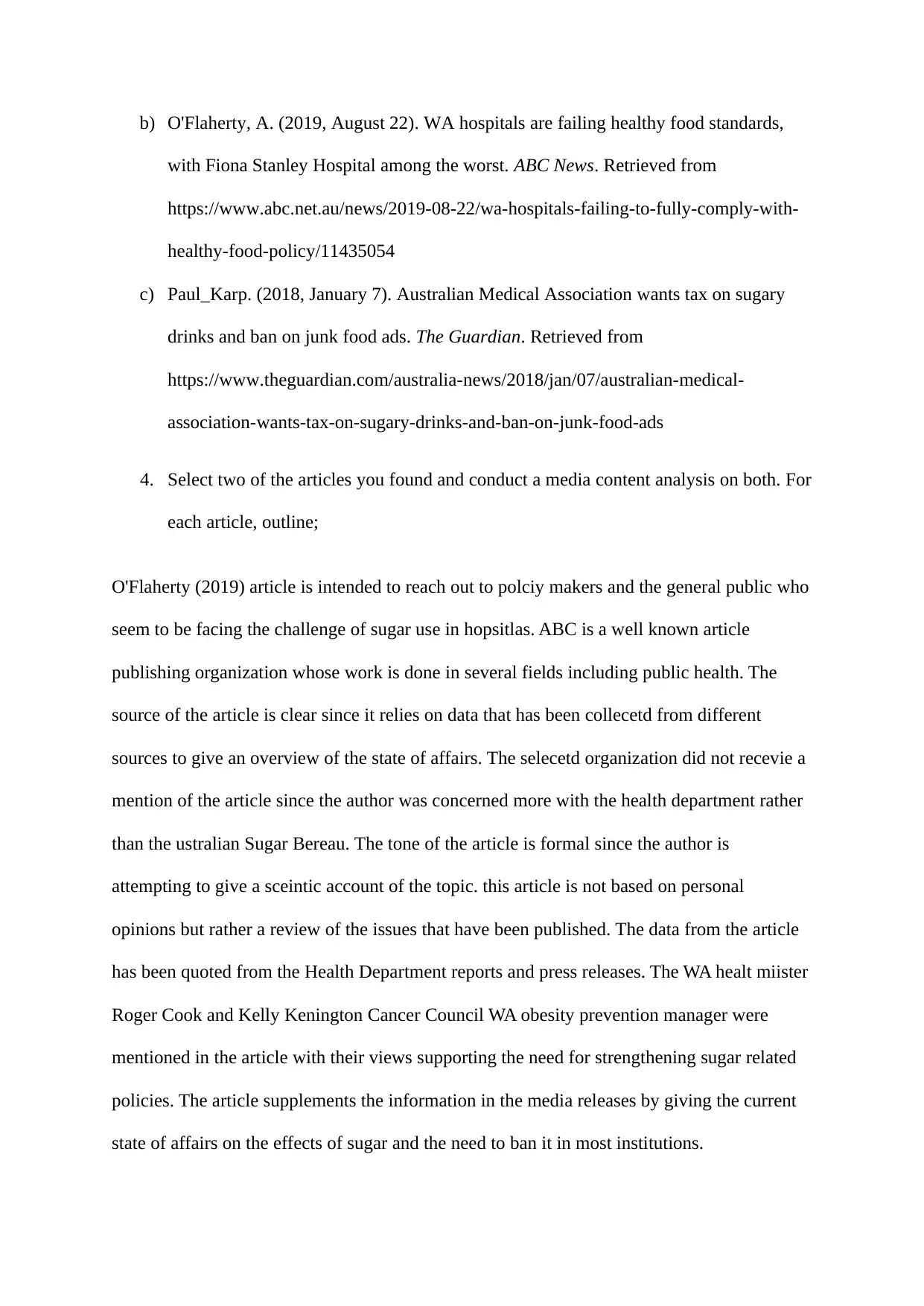
b) O'Flaherty, A. (2019, August 22). WA hospitals are failing healthy food standards,
with Fiona Stanley Hospital among the worst. ABC News. Retrieved from
https://www.abc.net.au/news/2019-08-22/wa-hospitals-failing-to-fully-comply-with-
healthy-food-policy/11435054
c) Paul_Karp. (2018, January 7). Australian Medical Association wants tax on sugary
drinks and ban on junk food ads. The Guardian. Retrieved from
https://www.theguardian.com/australia-news/2018/jan/07/australian-medical-
association-wants-tax-on-sugary-drinks-and-ban-on-junk-food-ads
4. Select two of the articles you found and conduct a media content analysis on both. For
each article, outline;
O'Flaherty (2019) article is intended to reach out to polciy makers and the general public who
seem to be facing the challenge of sugar use in hopsitlas. ABC is a well known article
publishing organization whose work is done in several fields including public health. The
source of the article is clear since it relies on data that has been collecetd from different
sources to give an overview of the state of affairs. The selecetd organization did not recevie a
mention of the article since the author was concerned more with the health department rather
than the ustralian Sugar Bereau. The tone of the article is formal since the author is
attempting to give a sceintic account of the topic. this article is not based on personal
opinions but rather a review of the issues that have been published. The data from the article
has been quoted from the Health Department reports and press releases. The WA healt miister
Roger Cook and Kelly Kenington Cancer Council WA obesity prevention manager were
mentioned in the article with their views supporting the need for strengthening sugar related
policies. The article supplements the information in the media releases by giving the current
state of affairs on the effects of sugar and the need to ban it in most institutions.
with Fiona Stanley Hospital among the worst. ABC News. Retrieved from
https://www.abc.net.au/news/2019-08-22/wa-hospitals-failing-to-fully-comply-with-
healthy-food-policy/11435054
c) Paul_Karp. (2018, January 7). Australian Medical Association wants tax on sugary
drinks and ban on junk food ads. The Guardian. Retrieved from
https://www.theguardian.com/australia-news/2018/jan/07/australian-medical-
association-wants-tax-on-sugary-drinks-and-ban-on-junk-food-ads
4. Select two of the articles you found and conduct a media content analysis on both. For
each article, outline;
O'Flaherty (2019) article is intended to reach out to polciy makers and the general public who
seem to be facing the challenge of sugar use in hopsitlas. ABC is a well known article
publishing organization whose work is done in several fields including public health. The
source of the article is clear since it relies on data that has been collecetd from different
sources to give an overview of the state of affairs. The selecetd organization did not recevie a
mention of the article since the author was concerned more with the health department rather
than the ustralian Sugar Bereau. The tone of the article is formal since the author is
attempting to give a sceintic account of the topic. this article is not based on personal
opinions but rather a review of the issues that have been published. The data from the article
has been quoted from the Health Department reports and press releases. The WA healt miister
Roger Cook and Kelly Kenington Cancer Council WA obesity prevention manager were
mentioned in the article with their views supporting the need for strengthening sugar related
policies. The article supplements the information in the media releases by giving the current
state of affairs on the effects of sugar and the need to ban it in most institutions.
Paraphrase This Document
Need a fresh take? Get an instant paraphrase of this document with our AI Paraphraser
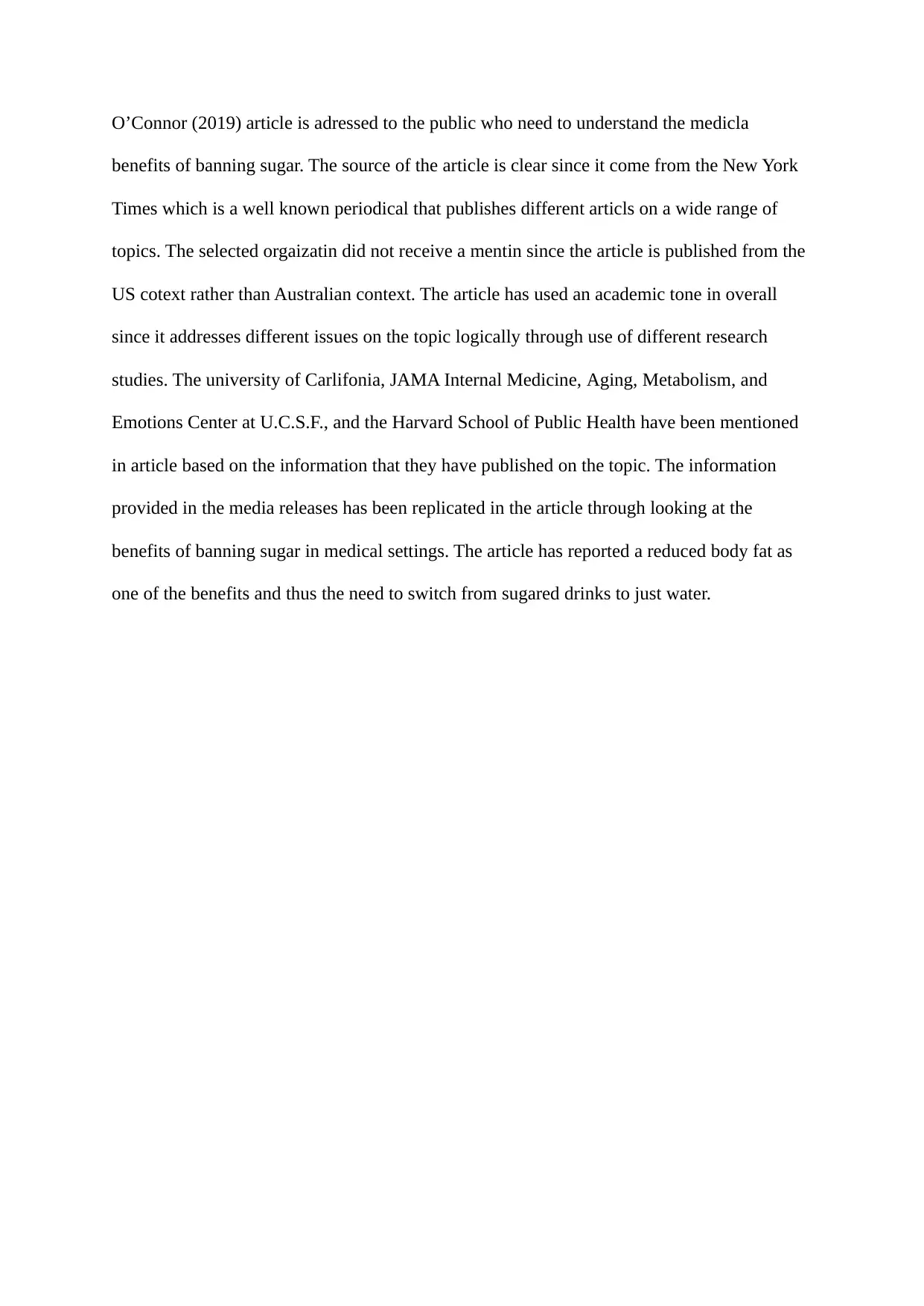
O’Connor (2019) article is adressed to the public who need to understand the medicla
benefits of banning sugar. The source of the article is clear since it come from the New York
Times which is a well known periodical that publishes different articls on a wide range of
topics. The selected orgaizatin did not receive a mentin since the article is published from the
US cotext rather than Australian context. The article has used an academic tone in overall
since it addresses different issues on the topic logically through use of different research
studies. The university of Carlifonia, JAMA Internal Medicine, Aging, Metabolism, and
Emotions Center at U.C.S.F., and the Harvard School of Public Health have been mentioned
in article based on the information that they have published on the topic. The information
provided in the media releases has been replicated in the article through looking at the
benefits of banning sugar in medical settings. The article has reported a reduced body fat as
one of the benefits and thus the need to switch from sugared drinks to just water.
benefits of banning sugar. The source of the article is clear since it come from the New York
Times which is a well known periodical that publishes different articls on a wide range of
topics. The selected orgaizatin did not receive a mentin since the article is published from the
US cotext rather than Australian context. The article has used an academic tone in overall
since it addresses different issues on the topic logically through use of different research
studies. The university of Carlifonia, JAMA Internal Medicine, Aging, Metabolism, and
Emotions Center at U.C.S.F., and the Harvard School of Public Health have been mentioned
in article based on the information that they have published on the topic. The information
provided in the media releases has been replicated in the article through looking at the
benefits of banning sugar in medical settings. The article has reported a reduced body fat as
one of the benefits and thus the need to switch from sugared drinks to just water.
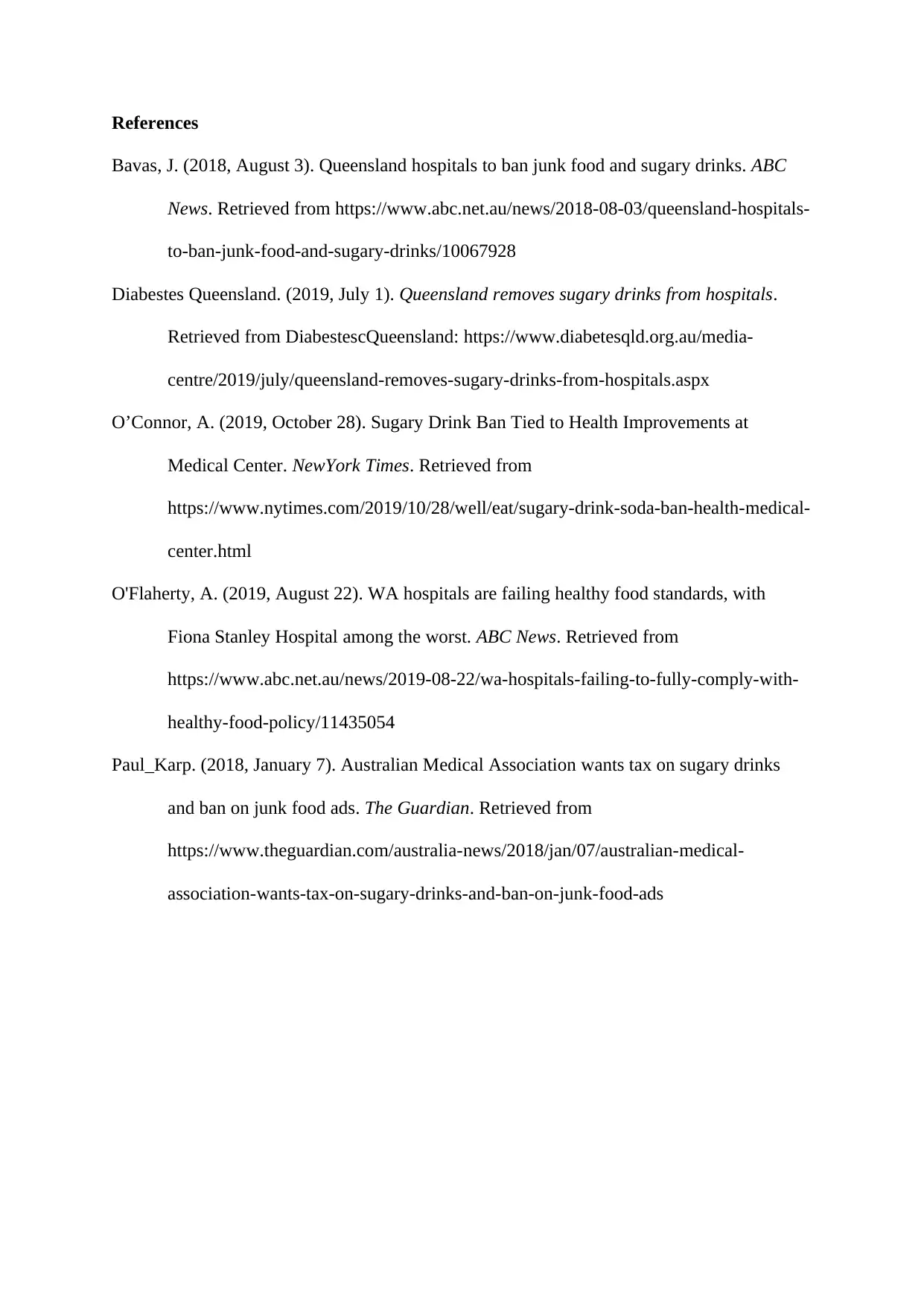
References
Bavas, J. (2018, August 3). Queensland hospitals to ban junk food and sugary drinks. ABC
News. Retrieved from https://www.abc.net.au/news/2018-08-03/queensland-hospitals-
to-ban-junk-food-and-sugary-drinks/10067928
Diabestes Queensland. (2019, July 1). Queensland removes sugary drinks from hospitals.
Retrieved from DiabestescQueensland: https://www.diabetesqld.org.au/media-
centre/2019/july/queensland-removes-sugary-drinks-from-hospitals.aspx
O’Connor, A. (2019, October 28). Sugary Drink Ban Tied to Health Improvements at
Medical Center. NewYork Times. Retrieved from
https://www.nytimes.com/2019/10/28/well/eat/sugary-drink-soda-ban-health-medical-
center.html
O'Flaherty, A. (2019, August 22). WA hospitals are failing healthy food standards, with
Fiona Stanley Hospital among the worst. ABC News. Retrieved from
https://www.abc.net.au/news/2019-08-22/wa-hospitals-failing-to-fully-comply-with-
healthy-food-policy/11435054
Paul_Karp. (2018, January 7). Australian Medical Association wants tax on sugary drinks
and ban on junk food ads. The Guardian. Retrieved from
https://www.theguardian.com/australia-news/2018/jan/07/australian-medical-
association-wants-tax-on-sugary-drinks-and-ban-on-junk-food-ads
Bavas, J. (2018, August 3). Queensland hospitals to ban junk food and sugary drinks. ABC
News. Retrieved from https://www.abc.net.au/news/2018-08-03/queensland-hospitals-
to-ban-junk-food-and-sugary-drinks/10067928
Diabestes Queensland. (2019, July 1). Queensland removes sugary drinks from hospitals.
Retrieved from DiabestescQueensland: https://www.diabetesqld.org.au/media-
centre/2019/july/queensland-removes-sugary-drinks-from-hospitals.aspx
O’Connor, A. (2019, October 28). Sugary Drink Ban Tied to Health Improvements at
Medical Center. NewYork Times. Retrieved from
https://www.nytimes.com/2019/10/28/well/eat/sugary-drink-soda-ban-health-medical-
center.html
O'Flaherty, A. (2019, August 22). WA hospitals are failing healthy food standards, with
Fiona Stanley Hospital among the worst. ABC News. Retrieved from
https://www.abc.net.au/news/2019-08-22/wa-hospitals-failing-to-fully-comply-with-
healthy-food-policy/11435054
Paul_Karp. (2018, January 7). Australian Medical Association wants tax on sugary drinks
and ban on junk food ads. The Guardian. Retrieved from
https://www.theguardian.com/australia-news/2018/jan/07/australian-medical-
association-wants-tax-on-sugary-drinks-and-ban-on-junk-food-ads
⊘ This is a preview!⊘
Do you want full access?
Subscribe today to unlock all pages.

Trusted by 1+ million students worldwide
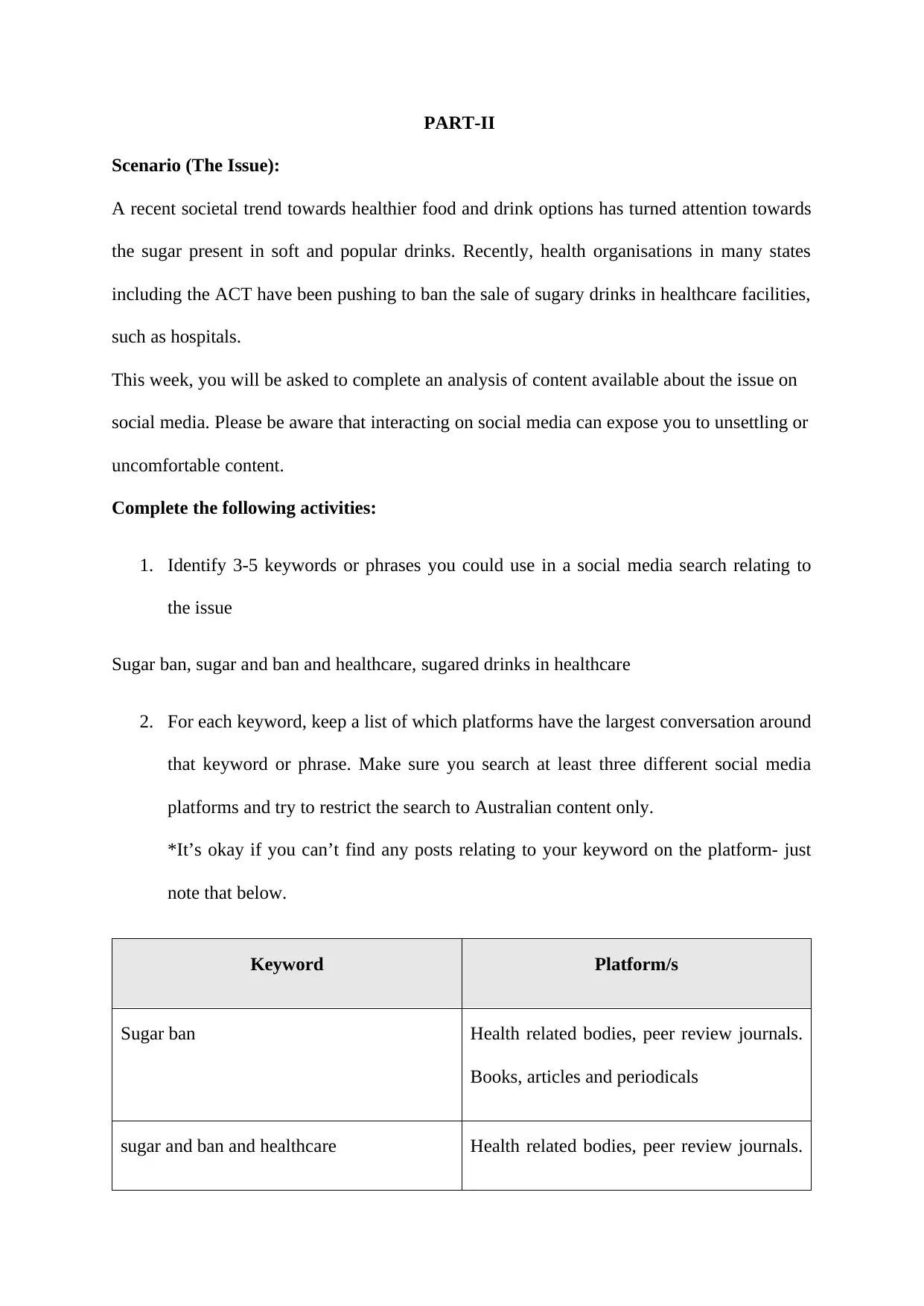
PART-II
Scenario (The Issue):
A recent societal trend towards healthier food and drink options has turned attention towards
the sugar present in soft and popular drinks. Recently, health organisations in many states
including the ACT have been pushing to ban the sale of sugary drinks in healthcare facilities,
such as hospitals.
This week, you will be asked to complete an analysis of content available about the issue on
social media. Please be aware that interacting on social media can expose you to unsettling or
uncomfortable content.
Complete the following activities:
1. Identify 3-5 keywords or phrases you could use in a social media search relating to
the issue
Sugar ban, sugar and ban and healthcare, sugared drinks in healthcare
2. For each keyword, keep a list of which platforms have the largest conversation around
that keyword or phrase. Make sure you search at least three different social media
platforms and try to restrict the search to Australian content only.
*It’s okay if you can’t find any posts relating to your keyword on the platform- just
note that below.
Keyword Platform/s
Sugar ban Health related bodies, peer review journals.
Books, articles and periodicals
sugar and ban and healthcare Health related bodies, peer review journals.
Scenario (The Issue):
A recent societal trend towards healthier food and drink options has turned attention towards
the sugar present in soft and popular drinks. Recently, health organisations in many states
including the ACT have been pushing to ban the sale of sugary drinks in healthcare facilities,
such as hospitals.
This week, you will be asked to complete an analysis of content available about the issue on
social media. Please be aware that interacting on social media can expose you to unsettling or
uncomfortable content.
Complete the following activities:
1. Identify 3-5 keywords or phrases you could use in a social media search relating to
the issue
Sugar ban, sugar and ban and healthcare, sugared drinks in healthcare
2. For each keyword, keep a list of which platforms have the largest conversation around
that keyword or phrase. Make sure you search at least three different social media
platforms and try to restrict the search to Australian content only.
*It’s okay if you can’t find any posts relating to your keyword on the platform- just
note that below.
Keyword Platform/s
Sugar ban Health related bodies, peer review journals.
Books, articles and periodicals
sugar and ban and healthcare Health related bodies, peer review journals.
Paraphrase This Document
Need a fresh take? Get an instant paraphrase of this document with our AI Paraphraser
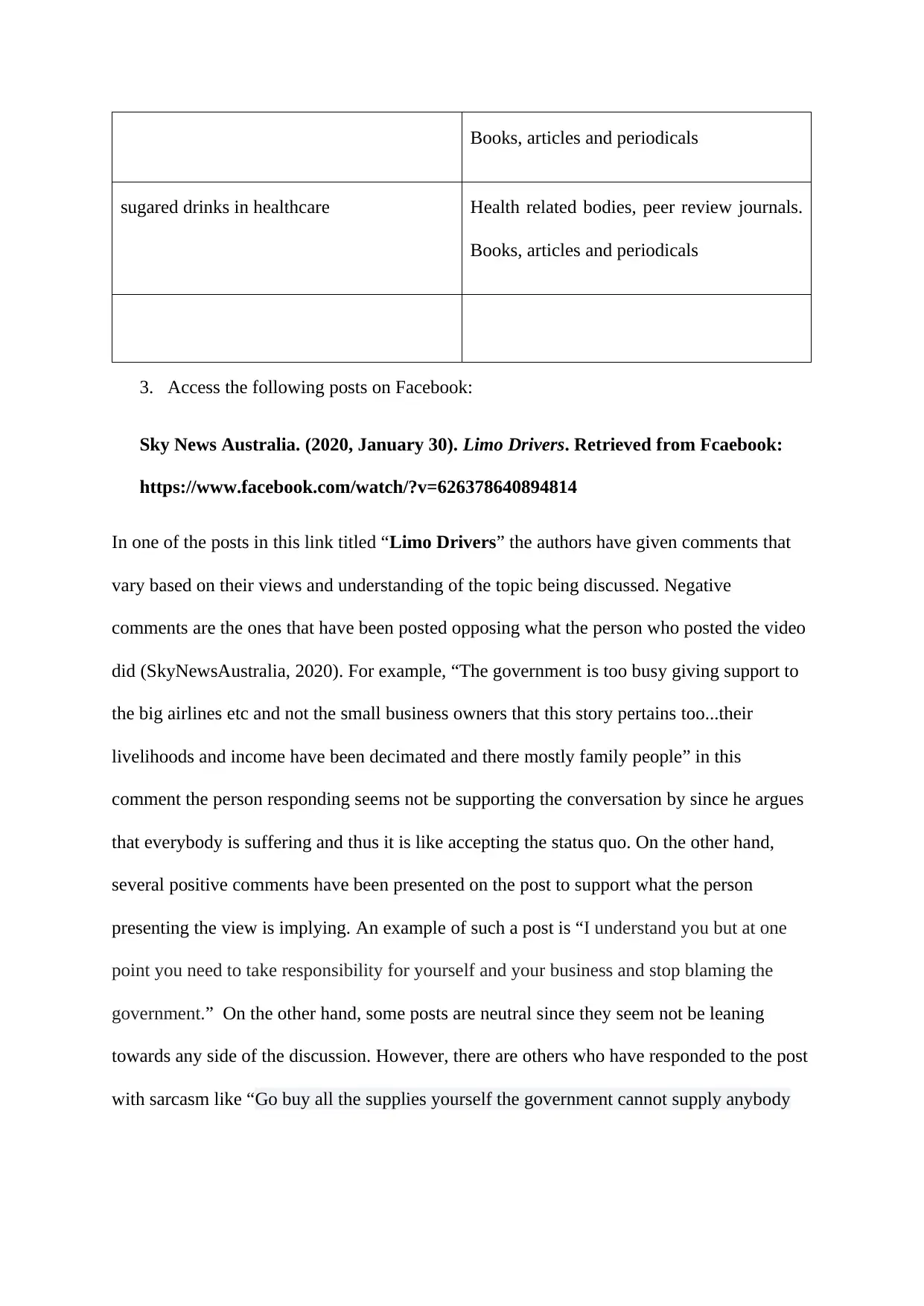
Books, articles and periodicals
sugared drinks in healthcare Health related bodies, peer review journals.
Books, articles and periodicals
3. Access the following posts on Facebook:
Sky News Australia. (2020, January 30). Limo Drivers. Retrieved from Fcaebook:
https://www.facebook.com/watch/?v=626378640894814
In one of the posts in this link titled “Limo Drivers” the authors have given comments that
vary based on their views and understanding of the topic being discussed. Negative
comments are the ones that have been posted opposing what the person who posted the video
did (SkyNewsAustralia, 2020). For example, “The government is too busy giving support to
the big airlines etc and not the small business owners that this story pertains too...their
livelihoods and income have been decimated and there mostly family people” in this
comment the person responding seems not be supporting the conversation by since he argues
that everybody is suffering and thus it is like accepting the status quo. On the other hand,
several positive comments have been presented on the post to support what the person
presenting the view is implying. An example of such a post is “I understand you but at one
point you need to take responsibility for yourself and your business and stop blaming the
government.” On the other hand, some posts are neutral since they seem not be leaning
towards any side of the discussion. However, there are others who have responded to the post
with sarcasm like “Go buy all the supplies yourself the government cannot supply anybody
sugared drinks in healthcare Health related bodies, peer review journals.
Books, articles and periodicals
3. Access the following posts on Facebook:
Sky News Australia. (2020, January 30). Limo Drivers. Retrieved from Fcaebook:
https://www.facebook.com/watch/?v=626378640894814
In one of the posts in this link titled “Limo Drivers” the authors have given comments that
vary based on their views and understanding of the topic being discussed. Negative
comments are the ones that have been posted opposing what the person who posted the video
did (SkyNewsAustralia, 2020). For example, “The government is too busy giving support to
the big airlines etc and not the small business owners that this story pertains too...their
livelihoods and income have been decimated and there mostly family people” in this
comment the person responding seems not be supporting the conversation by since he argues
that everybody is suffering and thus it is like accepting the status quo. On the other hand,
several positive comments have been presented on the post to support what the person
presenting the view is implying. An example of such a post is “I understand you but at one
point you need to take responsibility for yourself and your business and stop blaming the
government.” On the other hand, some posts are neutral since they seem not be leaning
towards any side of the discussion. However, there are others who have responded to the post
with sarcasm like “Go buy all the supplies yourself the government cannot supply anybody
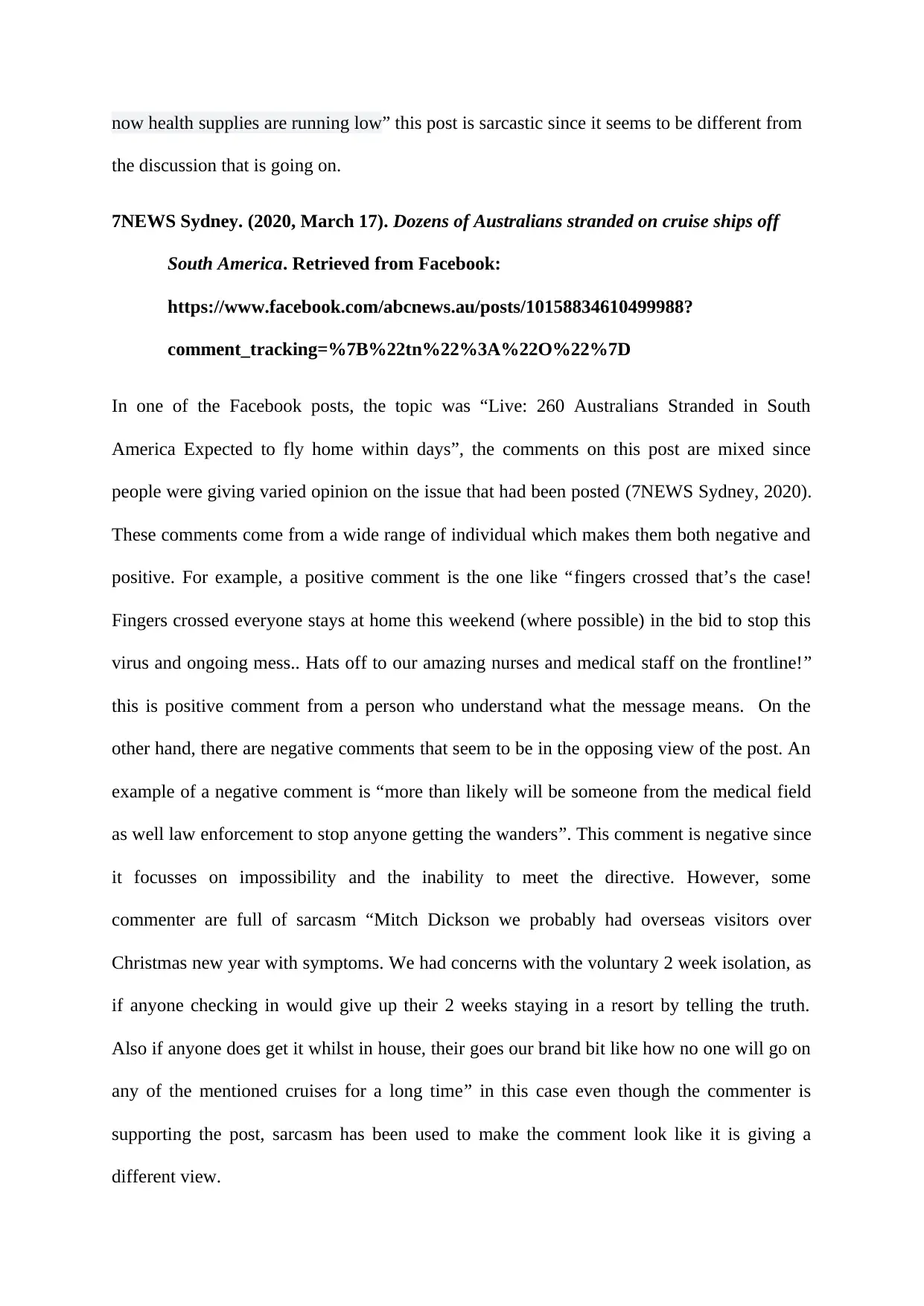
now health supplies are running low” this post is sarcastic since it seems to be different from
the discussion that is going on.
7NEWS Sydney. (2020, March 17). Dozens of Australians stranded on cruise ships off
South America. Retrieved from Facebook:
https://www.facebook.com/abcnews.au/posts/10158834610499988?
comment_tracking=%7B%22tn%22%3A%22O%22%7D
In one of the Facebook posts, the topic was “Live: 260 Australians Stranded in South
America Expected to fly home within days”, the comments on this post are mixed since
people were giving varied opinion on the issue that had been posted (7NEWS Sydney, 2020).
These comments come from a wide range of individual which makes them both negative and
positive. For example, a positive comment is the one like “fingers crossed that’s the case!
Fingers crossed everyone stays at home this weekend (where possible) in the bid to stop this
virus and ongoing mess.. Hats off to our amazing nurses and medical staff on the frontline!”
this is positive comment from a person who understand what the message means. On the
other hand, there are negative comments that seem to be in the opposing view of the post. An
example of a negative comment is “more than likely will be someone from the medical field
as well law enforcement to stop anyone getting the wanders”. This comment is negative since
it focusses on impossibility and the inability to meet the directive. However, some
commenter are full of sarcasm “Mitch Dickson we probably had overseas visitors over
Christmas new year with symptoms. We had concerns with the voluntary 2 week isolation, as
if anyone checking in would give up their 2 weeks staying in a resort by telling the truth.
Also if anyone does get it whilst in house, their goes our brand bit like how no one will go on
any of the mentioned cruises for a long time” in this case even though the commenter is
supporting the post, sarcasm has been used to make the comment look like it is giving a
different view.
the discussion that is going on.
7NEWS Sydney. (2020, March 17). Dozens of Australians stranded on cruise ships off
South America. Retrieved from Facebook:
https://www.facebook.com/abcnews.au/posts/10158834610499988?
comment_tracking=%7B%22tn%22%3A%22O%22%7D
In one of the Facebook posts, the topic was “Live: 260 Australians Stranded in South
America Expected to fly home within days”, the comments on this post are mixed since
people were giving varied opinion on the issue that had been posted (7NEWS Sydney, 2020).
These comments come from a wide range of individual which makes them both negative and
positive. For example, a positive comment is the one like “fingers crossed that’s the case!
Fingers crossed everyone stays at home this weekend (where possible) in the bid to stop this
virus and ongoing mess.. Hats off to our amazing nurses and medical staff on the frontline!”
this is positive comment from a person who understand what the message means. On the
other hand, there are negative comments that seem to be in the opposing view of the post. An
example of a negative comment is “more than likely will be someone from the medical field
as well law enforcement to stop anyone getting the wanders”. This comment is negative since
it focusses on impossibility and the inability to meet the directive. However, some
commenter are full of sarcasm “Mitch Dickson we probably had overseas visitors over
Christmas new year with symptoms. We had concerns with the voluntary 2 week isolation, as
if anyone checking in would give up their 2 weeks staying in a resort by telling the truth.
Also if anyone does get it whilst in house, their goes our brand bit like how no one will go on
any of the mentioned cruises for a long time” in this case even though the commenter is
supporting the post, sarcasm has been used to make the comment look like it is giving a
different view.
⊘ This is a preview!⊘
Do you want full access?
Subscribe today to unlock all pages.

Trusted by 1+ million students worldwide
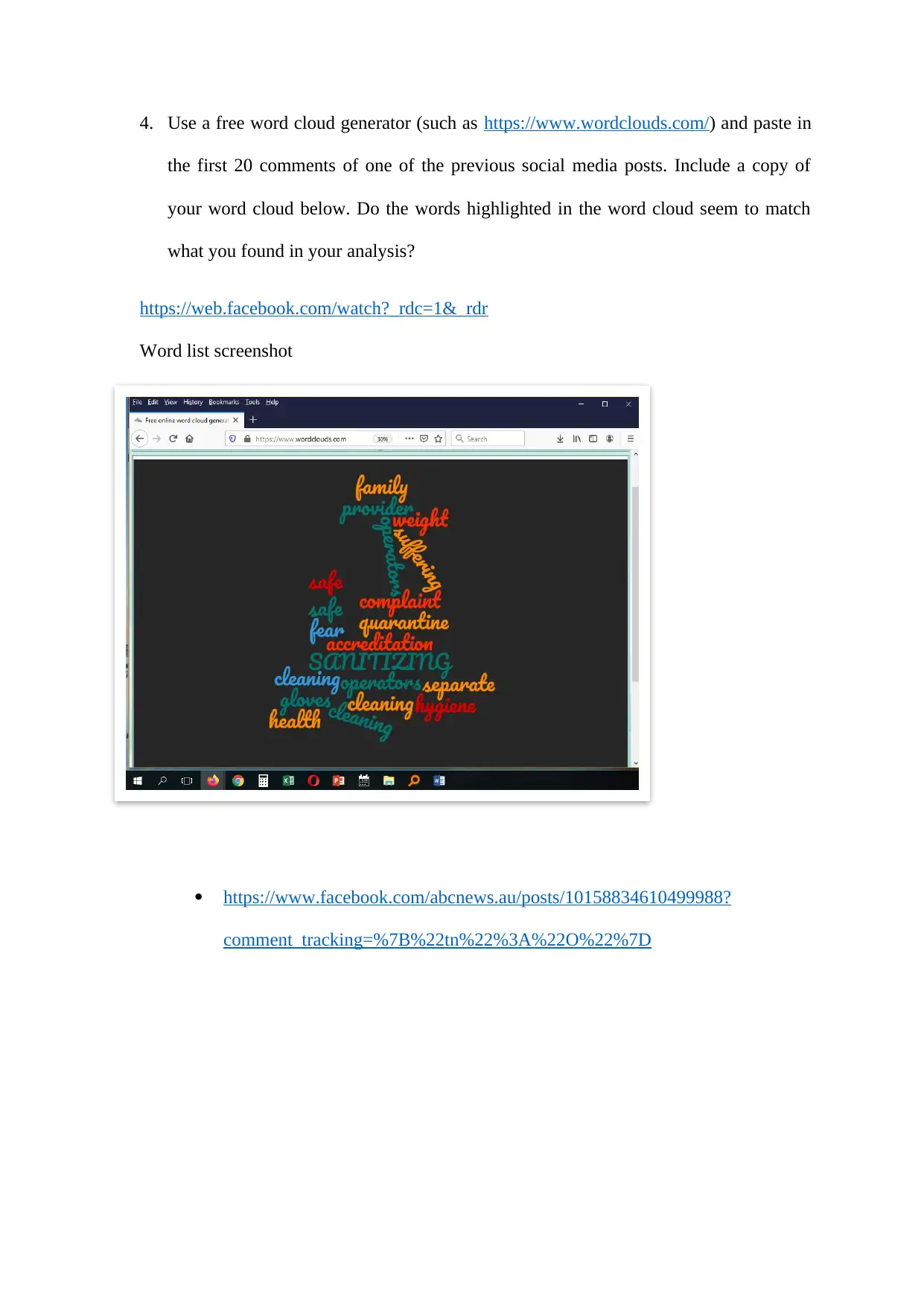
4. Use a free word cloud generator (such as https://www.wordclouds.com/) and paste in
the first 20 comments of one of the previous social media posts. Include a copy of
your word cloud below. Do the words highlighted in the word cloud seem to match
what you found in your analysis?
https://web.facebook.com/watch?_rdc=1&_rdr
Word list screenshot
https://www.facebook.com/abcnews.au/posts/10158834610499988?
comment_tracking=%7B%22tn%22%3A%22O%22%7D
the first 20 comments of one of the previous social media posts. Include a copy of
your word cloud below. Do the words highlighted in the word cloud seem to match
what you found in your analysis?
https://web.facebook.com/watch?_rdc=1&_rdr
Word list screenshot
https://www.facebook.com/abcnews.au/posts/10158834610499988?
comment_tracking=%7B%22tn%22%3A%22O%22%7D
Paraphrase This Document
Need a fresh take? Get an instant paraphrase of this document with our AI Paraphraser
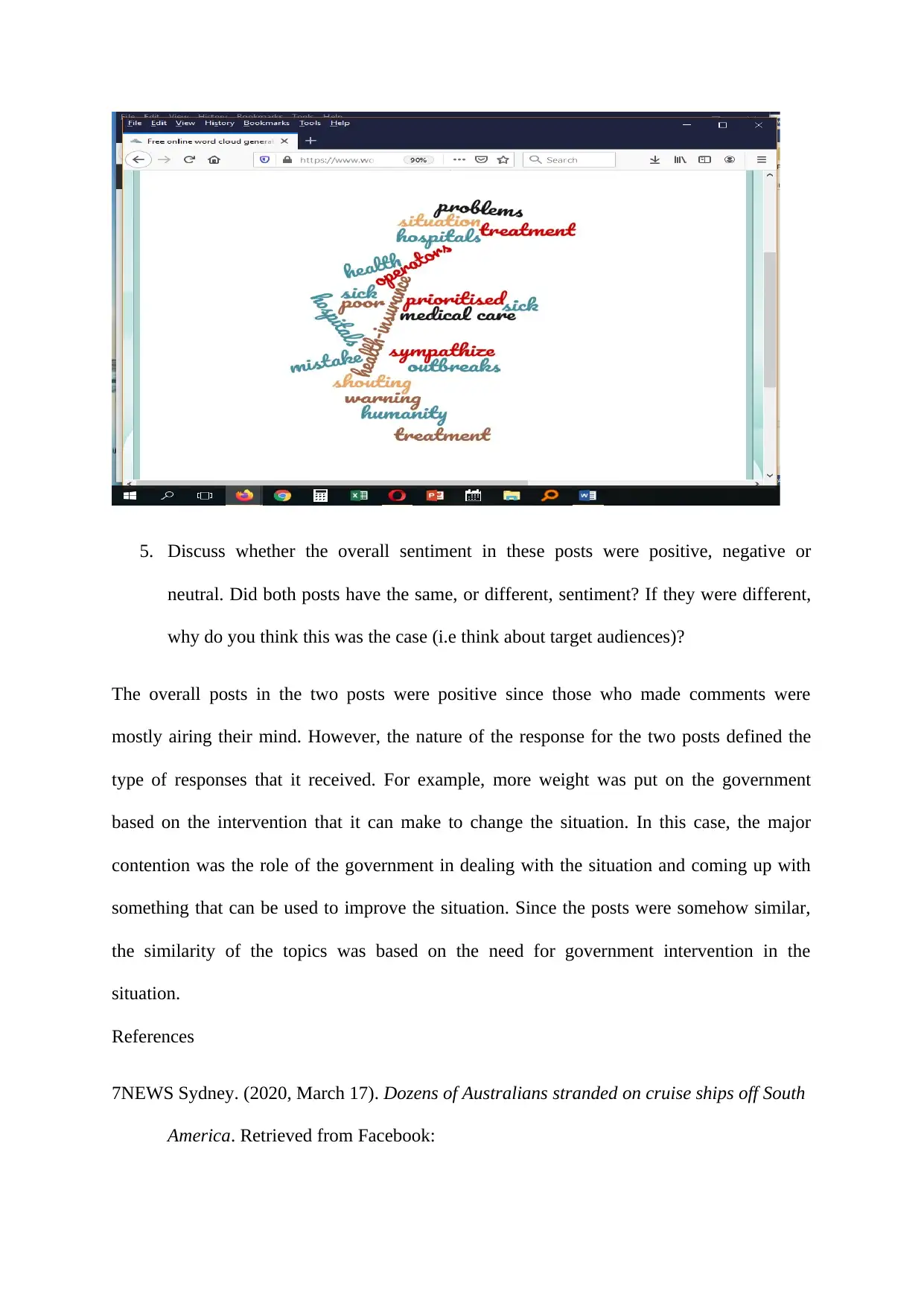
5. Discuss whether the overall sentiment in these posts were positive, negative or
neutral. Did both posts have the same, or different, sentiment? If they were different,
why do you think this was the case (i.e think about target audiences)?
The overall posts in the two posts were positive since those who made comments were
mostly airing their mind. However, the nature of the response for the two posts defined the
type of responses that it received. For example, more weight was put on the government
based on the intervention that it can make to change the situation. In this case, the major
contention was the role of the government in dealing with the situation and coming up with
something that can be used to improve the situation. Since the posts were somehow similar,
the similarity of the topics was based on the need for government intervention in the
situation.
References
7NEWS Sydney. (2020, March 17). Dozens of Australians stranded on cruise ships off South
America. Retrieved from Facebook:
neutral. Did both posts have the same, or different, sentiment? If they were different,
why do you think this was the case (i.e think about target audiences)?
The overall posts in the two posts were positive since those who made comments were
mostly airing their mind. However, the nature of the response for the two posts defined the
type of responses that it received. For example, more weight was put on the government
based on the intervention that it can make to change the situation. In this case, the major
contention was the role of the government in dealing with the situation and coming up with
something that can be used to improve the situation. Since the posts were somehow similar,
the similarity of the topics was based on the need for government intervention in the
situation.
References
7NEWS Sydney. (2020, March 17). Dozens of Australians stranded on cruise ships off South
America. Retrieved from Facebook:
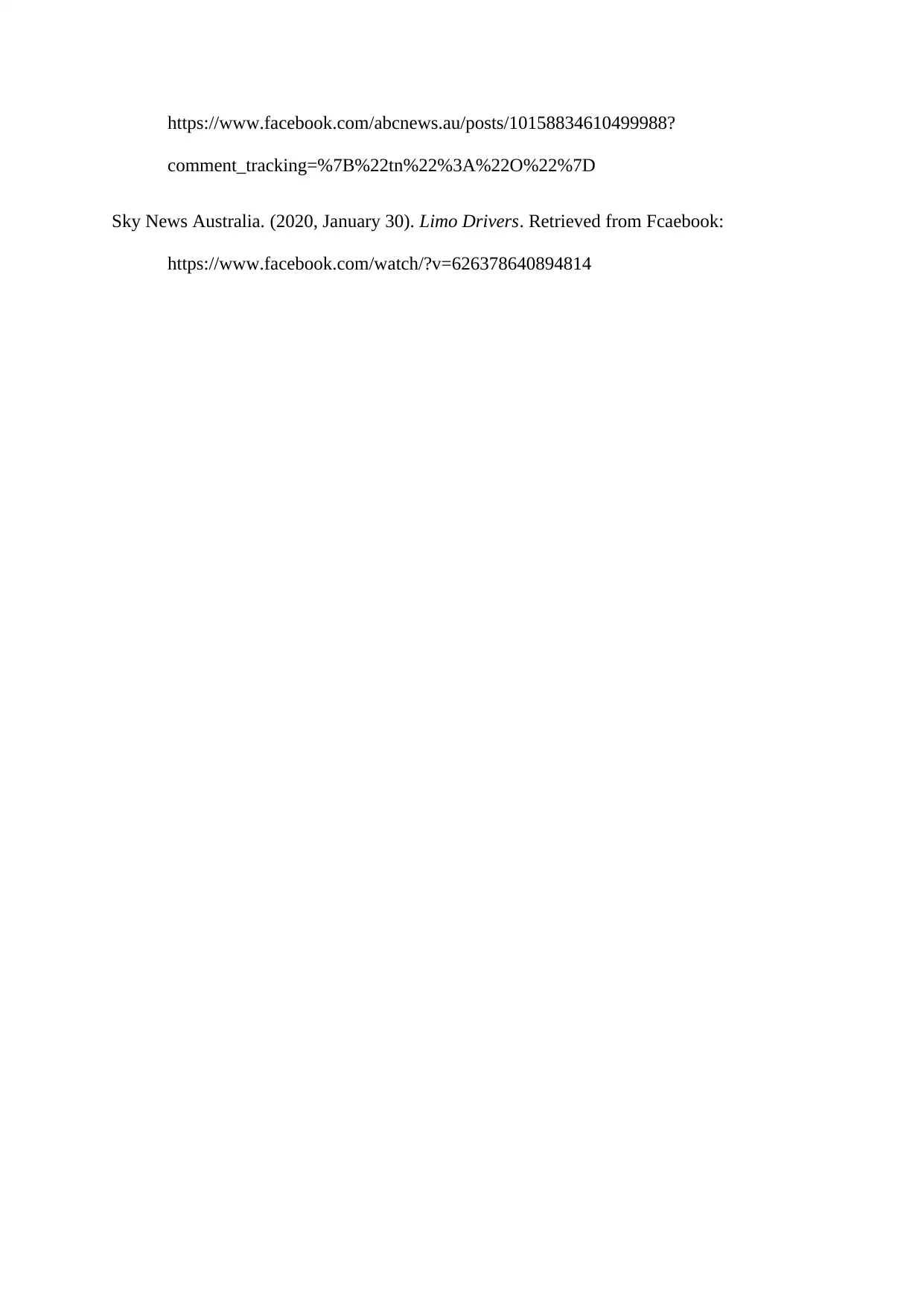
https://www.facebook.com/abcnews.au/posts/10158834610499988?
comment_tracking=%7B%22tn%22%3A%22O%22%7D
Sky News Australia. (2020, January 30). Limo Drivers. Retrieved from Fcaebook:
https://www.facebook.com/watch/?v=626378640894814
comment_tracking=%7B%22tn%22%3A%22O%22%7D
Sky News Australia. (2020, January 30). Limo Drivers. Retrieved from Fcaebook:
https://www.facebook.com/watch/?v=626378640894814
⊘ This is a preview!⊘
Do you want full access?
Subscribe today to unlock all pages.

Trusted by 1+ million students worldwide
1 out of 12
Your All-in-One AI-Powered Toolkit for Academic Success.
+13062052269
info@desklib.com
Available 24*7 on WhatsApp / Email
![[object Object]](/_next/static/media/star-bottom.7253800d.svg)
Unlock your academic potential
Copyright © 2020–2025 A2Z Services. All Rights Reserved. Developed and managed by ZUCOL.
